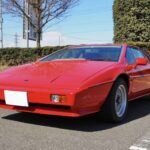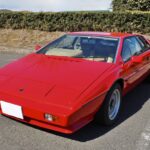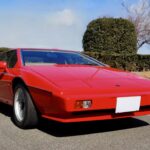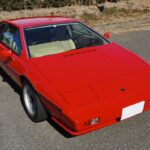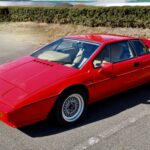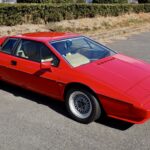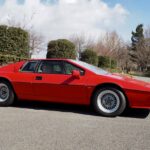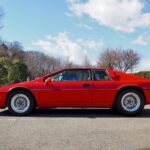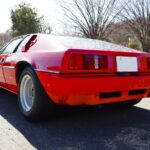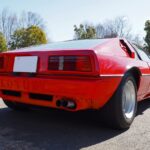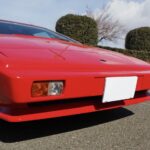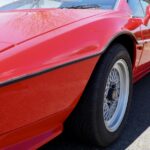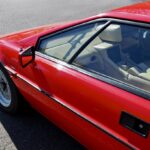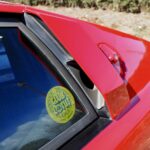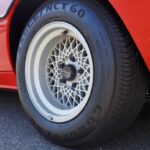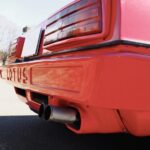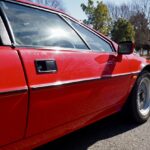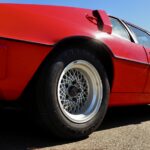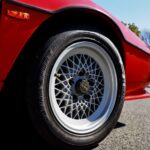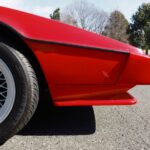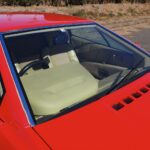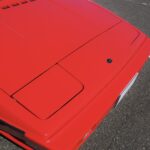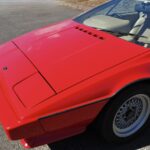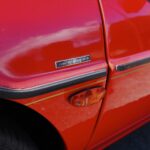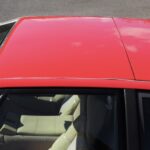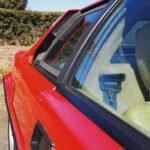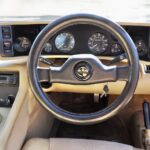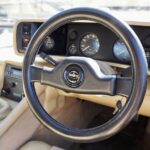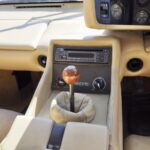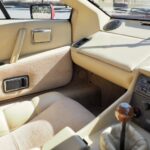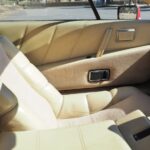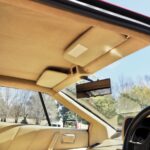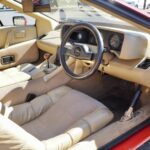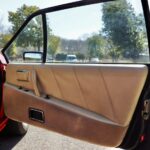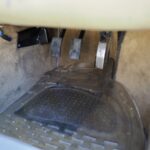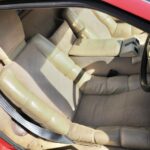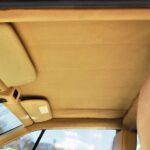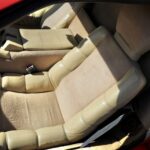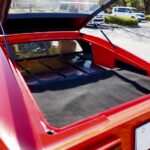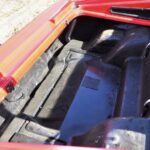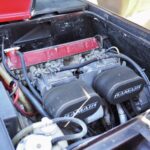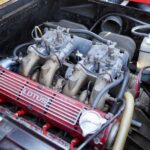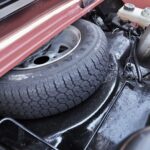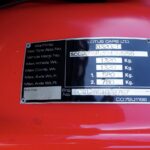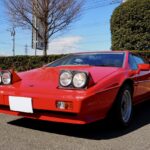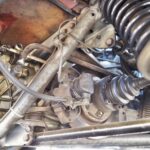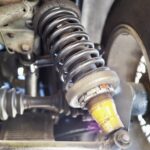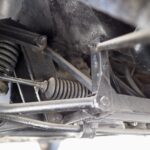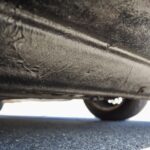TOP>Stock List>1985model Lotus Esprit S3
1985model
Lotus Esprit S3

↑↑↑Please watch the archived video above with audio if possible...
It is a sensuous—overwhelmingly beautiful—Giorgetto Giugiaro wedge shape...! Endlessly gazing at its pure beauty is an absolute joy. The matured, ultimate masterpiece of the series, the 1985 Lotus Esprit S3, was a machine that stirred the soul…!
It was a windy day, typical of the northern Kanto region, when I arrived for this special interview. The familiar owner—someone I’ve long had the pleasure of knowing—drove to the location in a hidden gem from his vast collection, a car he had cherished for a decade: a 1985 Lotus Esprit.
The deep crimson body, accentuated by fine black moldings, emphasized the exotic design. Through the crystal-clear windows, characteristic of British cars, the tan interior complemented the exterior beautifully. As the final evolution of Giugiaro’s design, the Series 3 was widely regarded as the most refined and aesthetically perfected model.
The car sat on wide, high-profile 60-series tires, embodying the quintessential 1970s–80s exotic car stance. Though undeniably imposing, it exuded an aura distinctly different from today’s flamboyant supercars—the prancing horses and raging bulls of the modern era. Instead, it stood as a proud relic of an era when sharp, angular wedges dominated automotive design. The Esprit’s ultra-low, razor-edged silhouette radiated presence, stopping me in my tracks. As someone who has a deep affinity for classic Lotus models and has restored two Lotus Europas in the past, I found myself momentarily forgetting my role as an interviewer, completely captivated by its “true beauty.”
When I asked the owner—who had once let go of his Elise to acquire this very car—about its history, he shared:
- Engine & Carburetor: The engine runs smoothly as is, but when he acquired the car ten years ago, the original Dell’Orto carburetors had already been replaced with Solex 44s.
- Tires: The front tires were changed from the original high-profile 195/60VR15 size to 205/55R15 (though Goodyear still offers the original size).
Aside from these modifications, the car remained a full, unrestored original, preserved meticulously. Over the past four decades, each of its careful owners had made minor cosmetic touch-ups, primarily to the front bumper, to maintain its stunning Calypso Red (paint code A23) without ever undergoing a full repaint.
The interior, upholstered in tan, further enhanced the brilliance of Calypso Red. Given the large forward-facing glass area, Esprits often suffered from sun-induced wear and tear, yet this one—stored exclusively in a fully enclosed garage—remained remarkably well-preserved. The D.N. combination leather-and-fabric seats, the two-spoke Momo steering wheel, the leather-clad instrument cluster, and even the expansive dashboard panel showed minimal cracking or damage. A light cleaning was all it needed—an astonishing testament to its originality.
Examining the underside revealed more of the car’s engineering excellence. The tilted tappet cover of the iconic 912 engine gleamed with an almost pristine finish. The drivetrain layout—a Citroën-built transmission, outboard brakes, and directly connected short driveshafts—was pure Lotus, reminiscent of a Formula car.
The owner had diligently addressed any oil leaks from the slanted tappet cover, ensuring the powertrain remained impeccably clean. This level of care made me think—whoever takes over this Lotus will undoubtedly experience the deep joy of owning a classic Lotus, a true masterpiece of its era.
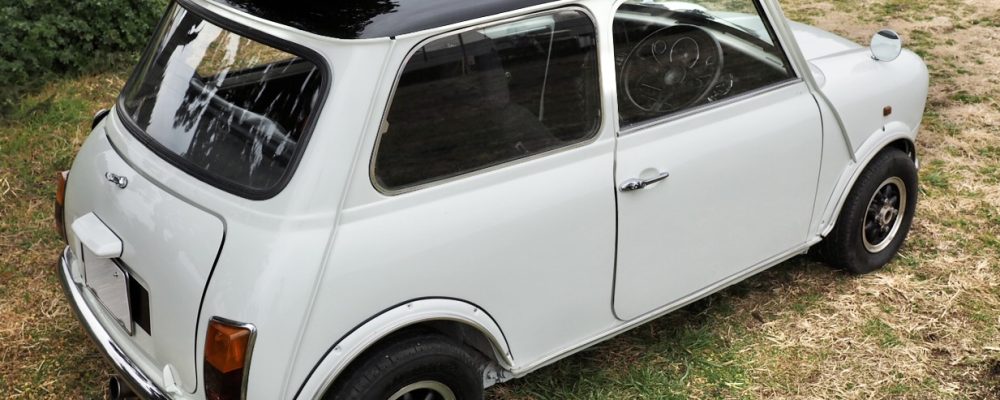
Unraveling the Essence of Lotus’ Captivating Driving Experience Through Its History—Beyond the “Super” Exotic Design!
The 1960s… In stark contrast to major corporations like Mercedes-Benz, which systematically entered races to showcase the appeal of their production cars, Lotus, a small-scale constructor specializing in formula cars, took an entirely opposite approach. The company would occasionally produce road cars, funded by the financial success gained through racing achievements. As a result, a select group of enthusiasts of that era had the rare opportunity to own a Lotus that could legally drive on public roads, experiencing an unparalleled driving sensation.
With such a rare and unique origin story, every time I encounter a vintage Lotus today, I cannot help but marvel, “How did they ever manage to mass-produce this car back then?”
Classic Lotus Esprits, with their distinctive structures derived from formula cars and an aura of uniqueness, have now become an endangered species.
Esprit S1 (1976-1978) Production Volume: 994 units
Esprit S2 (1978-1982) Production Volume: 1,149 units
Esprit S3 (1982-1988) Production Volume: 3,041 units
Despite these production numbers, nearly half a century has passed since the Esprit’s debut. As of 2025, even in the UK, the number of registered (Licensed) Esprits stands at only 330, with another 374 recorded as off-road (SORN). The number of surviving examples is dwindling rapidly.
(*Excerpted from the UK website “How Many Left”)
https://www.howmanyleft.co.uk/vehicle/lotus_esprit
Naturally, encountering a vintage Lotus that has been meticulously maintained and restored to its original condition provides an experience distinctly different from that of touching other production cars. It allows one to travel back in time and experience the aesthetic of a bygone era in the most tangible way. Driving a vintage Lotus Esprit is perhaps the purest means of engaging with the essence of Colin Chapman’s philosophy—encapsulating the engineering, design, and driving feel of 1970s-80s Britain.
Now, let’s delve into the fascinating story behind the birth of the exotic Esprit.
The Birth of the Lotus Esprit
In the early 1970s, Colin Chapman made a bold decision to break away from the niche lightweight sports cars Lotus had been producing, such as the Elan and Europa. He aimed to step into the realm of more exotic and daring super sports cars.
In 1971, Chapman met Giorgetto Giugiaro at the Geneva Motor Show, leading to the decision to bring him on as the designer for Lotus’ new model. Giugiaro’s Italdesign unveiled a concept car in November 1972, marking the birth of what would become a new Lotus icon.
With its sharp styling, featuring flat glass extending even to the front windshield, Giugiaro’s design was a masterclass in angular aesthetics. The concept received widespread acclaim, making a sensational debut. Initially, the prototype was built on a Maserati chassis. However, Giugiaro later requested Lotus to provide components from the Europa, leading to the use of Lotus’ own DOHC 16-valve Type 907 engine in the final production model.
Upon seeing Giugiaro’s sketches, Chapman immediately gave the green light for mass production. By September 1975, a production prototype was completed, and in October of the same year, the near-finalized Esprit was unveiled at the Paris Motor Show. It was hailed as “the most exciting and attractive British sports car since the Jaguar E-Type.”
The production model was officially launched in 1976. The aluminum body of the concept car was replaced with FRP, using Lotus’ signature hand-laid fiberglass construction, as seen in previous models like the Elan. The chassis featured a welded steel backbone subframe, a Lotus specialty.
Unlike the Europa, where the rear portion of the frame split into a Y-shape to accommodate the engine, the Esprit’s frame adopted a new hybrid structure. At the front of the engine compartment, a tubular space frame was integrated, while the rear half combined a backbone and tubular frame. This innovative approach allowed for a blend of rigidity and lightweight construction, creating the signature Lotus driving experience.
Evolution of the Esprit: S2 and S3
In 1978, the Esprit received its first major update with the introduction of the S2.
Key exterior changes included the addition of a front spoiler, black-painted side sills, air intakes on the rear quarter panels for improved engine cooling, and new four-spoke Speedline wheels, wider at the rear (7J front, 7.5J rear). The rear lights were replaced with larger units sourced from the Rover 3500. The interior also received enhancements, including a transition from rocker-arm switches to sliding-type controls for a more refined feel.
To address engine overheating issues, additional fans were installed in the rear wheel wells. The silencers and tailpipes were also upgraded to aluminum, though the engine itself remained largely unchanged.
However, significant structural modifications were made to the chassis. The rear brakes were moved outboard, requiring additional pipes beneath the transmission. The lower control arms were relocated from the transmission to the frame, while independent upper control arms replaced the previous driveshaft-mounted setup. This change detached the transmission from the chassis, allowing the engine and transmission to be fully floating-mounted.
The transmission was borrowed from the Citroën SM, as in the S1, but with revised final drive ratios in the S2. The front brake discs were enlarged to 10.5 inches, and the outboard-mounted rear brakes improved maintenance accessibility.
From the S2 onward, the wheels were sourced from Mahle BBS, with 7J 195/60VR15 tires at the front and 8J 235/60VR15 at the rear. These changes solidified the Esprit’s iconic 1980s exotic styling.
The Esprit S3 and Further Refinements
Despite widespread praise for its handling, demand for more power persisted. In May 1980, Lotus introduced the Type 912 engine, which was essentially a naturally aspirated version of the turbocharged Type 910.
The 2,173cc DOHC inline-four, managed by twin Dell’Orto DHLA45E carburetors, featured a bore and stroke of 95.28mm × 76.20mm, a compression ratio of 9.4, and produced 163 hp at 6,500 rpm with 23.0 kgm of torque at 5,000 rpm in its UK specification.
In April 1981, Lotus took another step forward with a major update, leading to the debut of the Esprit S3. This model featured the naturally aspirated Type 912 engine paired with the chassis developed for the Turbo Esprit.
The S3 inherited the redesigned chassis from the Turbo Esprit, further refining its structure. This iteration separated the transmission from the frame entirely, adopting a fully floating engine and transmission mount system.
With the S3, Lotus introduced what became known as the “new design” Esprit, marking a shift in the car’s aesthetic direction. The S3 was the final version designed by Giugiaro, and with its improved aerodynamics and refined details, it is considered by many to be the most complete and well-balanced Giugiaro Esprit.
Today, as the number of surviving examples dwindles, collectors worldwide are increasingly seeking out these last iterations of Giugiaro’s masterpiece, recognizing them as some of the most desirable classic Lotus models ever built.
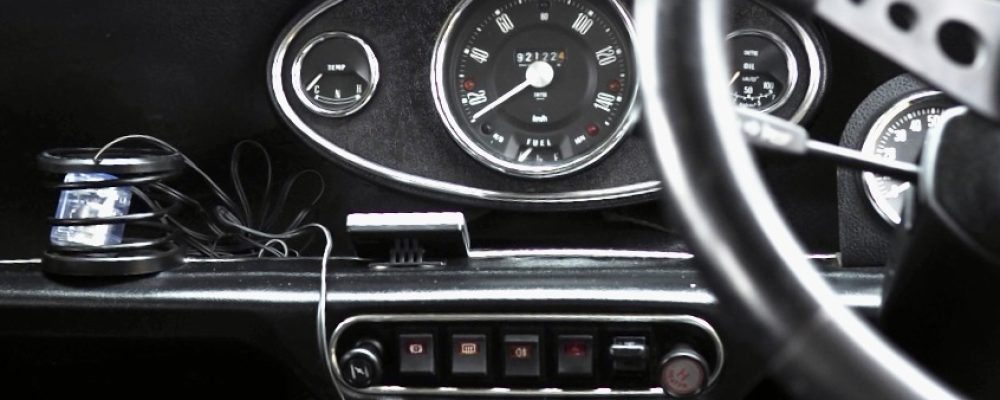
This particular Esprit is a rare right-hand-drive UK-spec model, despite the fact that most Esprits were exported to North America! It comes with a meticulously documented 10-year maintenance history...! Would you like to expand on its specific maintenance records or unique features?
This 1985 Lotus Esprit, finished in dazzling Calypso Red, bears the chassis number “SCC085912FHD12255”.
Reviewing the documentation from the owner, who has cherished this vehicle for the past ten years, we can decode the VIN as follows:
- SCC – Lotus
- 0 – UK domestic specification
- 85 – Esprit, Type 85
- 912 – 2.2L naturally aspirated engine
- F – Model year 1985
- H – Hethel factory, Norfolk, UK
- D – UK-specific chassis
- 1 – UK-specific engine
- 2255 – Serial number
According to the registration certificate, this Esprit was first registered in Japan in May 1996 (Heisei 8). The fact that the chassis number on the certificate was stamped under official authority suggests that this is a rare parallel import of a UK-spec model that arrived in Japan later.
Maintenance History Over the Past 10 Years
Since coming into the current owner’s possession, maintenance has been diligently carried out at almost every inspection, with no major issues reported. A review of the invoices reveals the following records:
September 2017 (Heisei 29)
- Routine inspection and maintenance
- Cam cover removal and surface repair to fix oil leakage
- Replacement of rear cam cap O-ring
- Overhaul of Solex carburetor, including gasket replacement, throttle linkage adjustment, and addition of a stopper
- Installation of 50mm velocity stacks, replacement of jet holder O-ring, and installation of RamAir filter
March 2020 (Reiwa 2)
- Routine inspection and maintenance
April 2023 (Reiwa 5)
- Routine inspection and maintenance
- Overhaul of clutch master cylinder, replacement of release bearing, banjo washer, and nipple, and clutch fluid change
- Overhaul of rear brake calipers, degreasing and installation of brake pads, brake fluid change
- Overhaul of water pump, replacement of gaskets, inlet hose, and repair of broken bolts
- Timing belt adjustment, coolant replacement, radiator cap replacement, and thermostat elbow bolt replacement
- Installation of a new reserve tank
- Degreasing and sealing of tappet cover oil leak
- Exhaust system removal and welding repair
- Lubrication of the right seat rail
- Removal and reinstallation of the trunk box
February 2024 (Reiwa 6)
- Replacement of spark plugs
- Replacement of fuel pump and fuel filter
- Custom fabrication of fuel hose joints
Current Condition
As of today, there are no known issues with the vehicle.
Notably, although air conditioning was an optional feature at the time, this particular Esprit does not have A/C, likely due to its UK-spec configuration.
Furthermore, based on the owner’s knowledge and a detailed inspection conducted on the day of documentation, this Esprit has no known accident history.

"1985 Lotus Esprit S3... Post-Interview Notes..."
The Esprit, viewed through the finder, was truly beautiful… No matter which point I chose to frame, the incredibly photogenic design by Giugiaro left me in awe. I lost myself in the moment, shooting over 400 photos… It reminded me of when I was in fifth grade, 50 years ago, desperately borrowing my father’s half-frame Olympus Pen and feverishly capturing images of Giugiaro’s raging bulls and Pininfarina’s prancing horses… I was so caught up in photographing these exotic cars, emblazoned with the Stuttgart crest, created by engineering doctors.
As you can see in the video I shot and edited… With the owner driving, I was able to experience the Esprit S3’s performance, where the 912 engine revs beautifully, on an empty country road… It was an exhilarating experience that truly embodies the unique world of classic Lotus! The intake sound produced by the twin 44mm Solex carburetors was intoxicating! The Lotus’s true strength—its direct handling—was evident as the car responded to every input with a precise, graceful turn, effortlessly navigating corners even at high speed, without a hint of struggle. The non-turbo, 2.2L 4-cylinder engine revved directly, and with the lightweight body, it provided a thrilling driving experience that left the driver exhilarated! This drive was uniquely smooth and sophisticated, far beyond the full-restored European versions, creating a driving experience that no other car on Earth can replicate… The classic Lotus, truly one of a kind, made me lose myself in the moment.
On the day of the interview, the owner gazed at my beloved car and said with a smile, “It’s really stylish, isn’t it?” Due to an inevitable “change in life stages,” the owner made the heart-wrenching decision to part with this car, leading to this interview request. But I’m sure the car will be cherished by its new owner, someone who will face it with sincerity and care. It is through meeting such an owner that the current owner can confidently say, “I know this person will be the right one to pass it on to…”
It was sensual—an overwhelmingly beautiful Giugiaro wedge shape! The pure beauty of it was so enjoyable to gaze upon endlessly. The 1985 Lotus Esprit S3, the pinnacle of the series in its matured form, was a car that truly stirred the soul…!
The great joy of spending countless hours in the garage, losing track of time, gazing at it through the night… Just taking it out on a weekend morning and cruising for 30 minutes on the nearby mountain roads is enough to cleanse the soul… After doing this for 10 years… Your sensitivity will be further nurtured, and you’ll find that life cannot be discussed without Giugiaro’s wedge shape. You’ll realize you’re trapped in an inescapable quagmire (laughs).
Such is the captivating, sensual world of the classic Lotus Esprit S3!
To experience the heartfelt thoughts of the owner, who has cherished this car for 10 years, in person… Please come to Gunma Prefecture for a firsthand look!
This 1985 Lotus Esprit S3 is currently located in Gunma Prefecture. As this is a private sale between individuals, there are no sales taxes or additional fees. However, the buyer will be responsible for the vehicle’s monthly proportional vehicle tax (annual amount ¥51,750) and the recycling deposit settlement (¥0, as no deposit has been made). The buyer will also need to arrange for transportation; however, the author’s company also offers classic car transport services using our own transport vehicle. Please feel free to reach out if you require assistance.
Regarding Inquiries… This vehicle is listed on the cross-border e-commerce site for classic and collectible cars, Estate Sale Supremacy®.
What is an ultimate (Supremacy) Estate Sale?
Estate Sale Supremacy® is a Japanese version of the North American estate sale culture, where we introduce vehicles with the owner’s personal story through interviews, articles, and videos, focusing on organizing both material and sentimental values. Unlike low-value transactions that involve quick buyouts, we genuinely express the owner’s feelings, keeping their memories alive, while ensuring a smooth transition to the next generation.
We conduct detailed interviews with the current owner regarding past maintenance records and repair history, including the presence of any accidents. If a major accident history exists or if the current ownership is unusually short with unclear details, we will refrain from conducting the interview and take steps to provide the buyer with as much assurance as possible.
This article is based on an interview with the owner, conducted on February 11, 2025 (Tuesday), at 10:30 AM, lasting approximately three hours. Please note that due to time constraints, the details may not fully reflect the exact condition of the vehicle. Also, the comments regarding the condition of the vehicle are based on subjective impressions during the interview and the weather conditions at that time.
For any questions regarding the listed vehicle or to request a viewing, please contact us using the link at the bottom of this page. As this is a private sale, only serious buyers who are considering the purchase should inquire for a viewing.
We appreciate your consideration and look forward to your inquiries.







